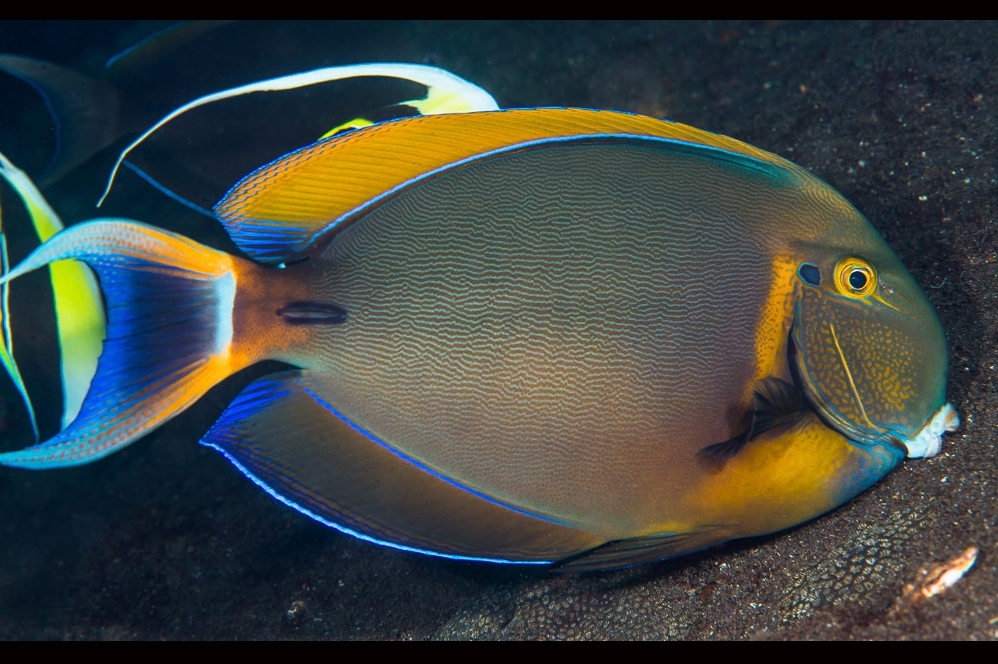| Citation |
|
Description |
Indo-West Pacific: Mozambique (Ref. 1920) and Maldives to the western Pacific.
Geographic Range [top]
Range Description: Acanthurus bariene is found from the Ryukyu Islands, Japan, southwards to the Great Barrier Reef, Australia (Ashmore Reef, Timor Sea, Western Australia (12°15S) and Lizard Island, Queensland (14°40S), eastwards to the Solomon Islands and westwards to the Seychelles. It was recently recorded from Christmas Island (J.H. Choat pers. comm. 2010).
Countries occurrence:
Native:
Australia; British Indian Ocean Territory; Brunei Darussalam; Cambodia; China; Christmas Island; Comoros; Disputed Territory (Paracel Is., Spratly Is.); Fiji; Hong Kong; India (Andaman Is., Nicobar Is.); Indonesia; Japan; Malaysia; Maldives; Mayotte; Micronesia, Federated States of ; Myanmar; Palau; Papua New Guinea; Philippines; Seychelles; Singapore; Solomon Islands; Taiwan, Province of China (Taiwan, Province of China (main island)); Thailand; Timor-Leste; Viet Nam
FAO Marine Fishing Areas:
Native:
Indian Ocean – western; Indian Ocean – eastern; Pacific – northwest; Pacific – western central
Additional data:
? Lower depth limit (metres): 50
? Upper depth limit (metres): 4
Range Map: Click here to open the map viewer and explore range.
Population [top]
Population: Acanthurus bariene was recorded as rare in terms of relative abundance in the northern Bismarck Sea and Milne Bay, Papua New Guinea (Allen 2003, 2009). It is occasionally found in Raja Ampat (Allen 2003b). It is common and locally abundant in the Philippines (C. Nanola pers. comm. 2010).
Current Population Trend: Unknown
Additional data:
? Population severely fragmented: No
Habitat and Ecology [top]
Habitat and Ecology: Acanthurus bariene is generally found in depths greater than 10 m and extending to at least 50 m on outer reef slopes and drop offs. It is usually seen as solitary individuals grazing on reefs or compact sand surfaces and is relatively easy to approach underwater (Randall 2001). It is found singly or in pairs. It feeds on algal film on bare rocks and sand. Juveniles are found in shallow protected reefs, usually between soft coral, in 0.2-3 m depth (Lieske and Myers 1994). It is classified as a grazer/detritivore (J.H. Choat and D.R. Bellwood pers. obs. in Green and Bellwood 2009). A. bariene was found to be confined to deeper sandstone reefs in Bar Reef Marine Sanctuary (BRMS), northwestern Sri Lanka (Ohman et al. 1997).
The sexes are separate among the acanthurids and there is no evidence of sexual dimorphism (Reeson 1983).
Systems: Marine
Use and Trade [top]
Use and Trade: Acanthrus bariene is occasionally seen in fish markets. It is a targeted food fish in western Thailand (Allen 2005) and in the Philippines (R. Abesamis and C. Nanola pers. comm. 2010). It is harvested for the aquarium trade, selling for $69.99 - $449.95 (L. Rocha pers. comm. 2010).
Threats [top]
Major Threat(s): The range of this species overlaps the Coral Triangle where it is a targeted food fish. It is found in an area with known prevalence of illegal fishing practices and overfishing.
Surgeonfishes show varying degrees of habitat preference and utilization of coral reef habitats, with some species spending the majority of their life stages on coral reef while others primarily utilize seagrass beds, mangroves, algal beds, and /or rocky reefs. The majority of surgeonfishes are exclusively found on coral reef habitat, and of these, approximately 80% are experiencing a greater than 30% loss of coral reef area and degradation of coral reef habitat quality across their distributions. However, more research is needed to understand the long-term effects of coral reef habitat loss and degradation on these species populations. Widespread coral reef loss and declining habitat conditions are particularly worrying for species that recruit into areas with live coral cover, especially as studies have shown that protection of pristine habitats facilitate the persistence of adult populations in species that have spatially separated adult and juvenile habitats (Comeros-Raynal et al. 2012).
Conservation Actions [top]
Conservation Actions: There are no species-specific conservation measures in place for this species. Its distribution overlaps several marine protected areas in parts of its range.
Citation: Choat, J.H., Abesamis, R., Clements, K.D., McIlwain, J., Myers, R., Nanola, C., Rocha, L.A., Russell, B. & Stockwell, B. 2012. Acanthurus bariene. The IUCN Red List of Threatened Species 2012: e.T177978A1509145. http://dx.doi.org/10.2305/IUCN.UK.2012.RLTS.T177978A1509145.en. Downloaded on 04 September 2018.
Disclaimer: To make use of this information, please check the .
Feedback: If you see any errors or have any questions or suggestions on what is shown on this page, please provide us with feedback so that we can correct or extend the information provided
|

